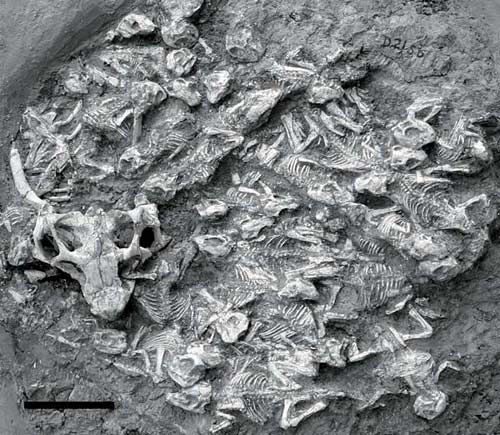The care of offspring in prehistoric times can explain the instincts of modern birds and crocodiles.
Paleontologists in China have unearthed a fossil resembling a nest of an adult dinosaur, along with 34 baby dinosaurs. This unique discovery indicates that at least some species of dinosaurs cared for their young after hatching, suggesting that the parenting instincts of today’s birds and reptiles, such as crocodiles, may share an evolutionary origin.

Surrounding the remains of the adult dinosaur are 34 baby dinosaurs
(Photo: pharyngula)
This fossil of the horned dinosaur Psittacosaurus includes a fully grown individual and 34 juveniles piled together in an area of about 0.5 m2. According to David Varricchio from Montana State University in Bozeman, a member of the archaeological team discovered these bones in Liaoning, China, indicating this is likely a family rather than a random collection of dinosaur fossils.
In an interview with [email protected], he stated, “This discovery is remarkable”; “This is likely to be a family. It is hard to imagine all these individual skeletons being transported to the same location at once.”
Simply a Nest?
Although it is believed that some groups of dinosaurs, such as theropods or hadrosaurs, did nest, this new discovery provides the first clear evidence of parental care in dinosaurs. It is currently unclear whether the 75 cm long adult in the nest was the father or mother, Varricchio noted. However, marking the gender of the parent does not necessarily follow a sequence when they care for their young. Varricchio further pointed out that in many living bird species, both parents help care for their offspring.
It is also unclear to what extent these dinosaur groups cared for their young. Perhaps the dinosaur parents simply kept the young close by to keep an eye on them, Varricchio suggested, similar to modern chickens. He remarked, “In many bird species, the young stay with their parents, and the adults lead them to food while they often linger behind the adults.”
“This is an astonishing ‘snapshot,’ incredible, and a remarkably unexpected discovery,” said Paul Barrett, a dinosaur expert at the Natural History Museum in London. However, he cautioned that the evidence of family life remains indirect at this stage.
Nonetheless, Barrett acknowledged that this arrangement hints at post-hatching care for young. The juveniles were all about 20 cm long, indicating they were from the same brood.
Cause of Death?
The curled-up positions of the fossils raise questions about what killed and preserved them. While volcanic eruption seems to be the most obvious culprit, Varricchio suggests it is hard to imagine that volcanic lava could bury these dinosaurs quickly enough to preserve them this way.
According to him, it is more likely that they were buried when a dirt burrow collapsed or drowned due to rising floodwaters. Many of the dinosaurs’ heads being raised could indicate the occurrence of such an event. Barrett also noted that the bowl-shaped depression where the fossils were found resembles a nest, although this remains speculative.
Whether dinosaurs lived and died in burrows is a question Varricchio hopes to answer soon, ideally with the help of other fossil discoveries. He believes that such findings could provide deeper insights into prehistoric family life. Previous discoveries have hinted at the possibility that psittacosaur species lived in groups of 3 to 4 adults, suggesting that a family with a pair of parents might not have been their standard.


















































